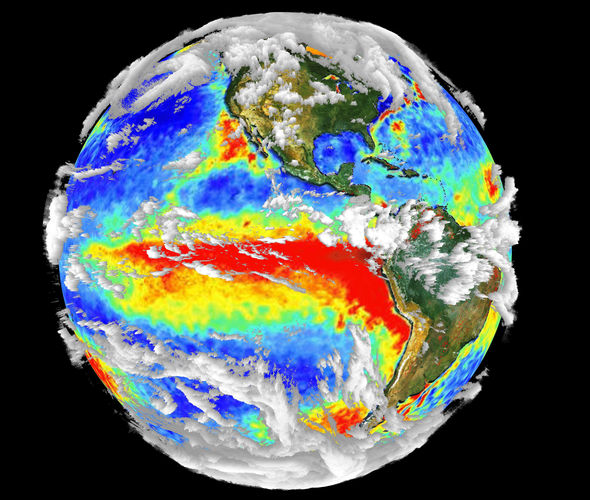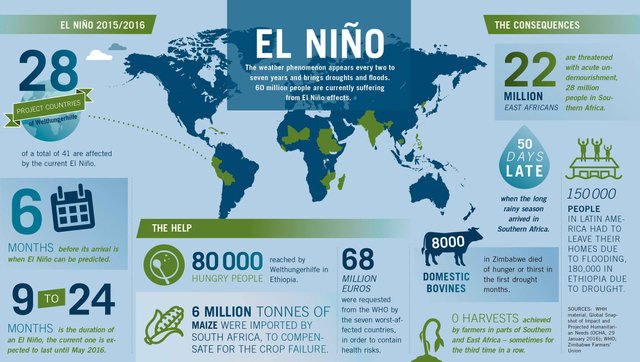El Niño
Hi friends, I hope you're fine?
In preparing my article on the Gulf Stream, I read some texts on the El Niño phenomenon. I had heard about it before but I did not know exactly what it was.

El Niño is a warm seasonal coastal current off Peru and Ecuador.
The El Niño phenomenon is a climatic phenomenon, different from the usual climate, which is characterized by unusually high water temperatures in the eastern part of the South Pacific Ocean.
It is connected to a cycle of variation of global atmospheric pressure between the East and the West Pacific, called the Southern Oscillation and the two phenomena are united under the title of ENSO: El Niño-Southern Oscillation.
El Niño is the consequence of a disturbance in the general atmospheric circulation between the poles and the equator. Its appearance displaces the areas of precipitation to the east in the Pacific Ocean and prevents the upwelling along the coast of South America. This phenomenon cuts the source of nutrients for wildlife in these waters and harms the fishing industry.
El Niño is one of the anomalies in the circulation that can divert tropical cyclones from their usual roads, displace rainfall and drought zones, and change the sea level locally by changing the average pressure.
Climate impact

His name was given by South American sinners who referred to Baby Jesus, as he appears shortly after Christmas.
Shortly after Christmas, until April, a small reverse coastal current sets in motion and flows south. At irregular intervals. The cold waters are replaced by warmer waters and the fish disappear from the coast, heavily affecting the activity of fishermen. In the same period, the low-rainfall coastal areas of northern Peru and Ecuador experience abundant rainfall, which is excellent for agriculture in these dry areas.
El Niño causes many climatic upheavals. The oceans and the atmosphere are continuously interacting. The changes induced on the sea surface temperature also affect the winds.
From 1982 to 1983 El Niño produced dramatic effects on the continents. In Ecuador and northern Peru, 250 cm of rain fell for six months. In the West, wind anomalies disturbed the typhoons of their usual routes to Hawaii or Tahiti that were not prepared for such weather conditions at all.
The phenomenon can affect by shock waves the climatic conditions in the most distant regions of the globe. The movement of tropical rains affects wind patterns all over the planet. The winds that are formed in the air above these clouds will determine the positions of the monsoons and the cyclone routes and belts of the intense winds separating the hot and cold regions on the surface of the Earth.
The impacts of El Niño on the climate are more evident in winter, for example, El Niño winters are mild over western Canada and parts of the northwestern United States and rainy over the southern United States, from Texas to Florida. El Niño also affects temperate climates during other seasons.
In 1997, El Niño caused droughts and forest fires in Indonesia, heavy rains in California and floods in the southeastern United States.
In late 1997, a huge storm dumped 25 cm of snow in the southeastern United States. Four-meter-high waves swept south of San Francisco. Violent storms hit Florida with tornadoes of 400 km / h.
According to a UN report, El Niño has left several thousand dead and wounded, and caused an estimated $ 32 billion to $ 96 billion in damages between 1997 and 1998.
In June 2002, El Niño caused severe thunderstorms in the tropical regions of South America.
By the end of December, Australia was experiencing the worst drought of the century dubbed the super-dry. Deadly storms have also been unleashed on the west coast of the United States.
In 2014, Pacific waters were warmer than normal and since the beginning of 2015 a shift from the hottest heart has been to the west coast of South America.
In August 2015, the seawater temperature measurement confirmed that El Niño was beginning and could be ranked among the four most intense since 1950.
The impacts of this episode reduced rainfall in Southeast Asia, Central America and northeastern South America by June.
It has increased the risk of drought in South Africa, East Asia, and flood risk in South America.
The fact that El Niño is now considered a global phenomenon, with repercussions in the three main tropical oceans, makes it easier to explain the climate disturbances around the world.
Impact on ecology and health
Temperature and rainfall are two major factors of ecological control.
Marine and island ecosystems are very sensitive to climate change and climate fluctuations.
One of the most spectacular effects is the disappearance of many species of fish west of the North American coasts. Wherever climate change is long and significant, ecosystems can be affected, especially where forest fires, storms, droughts or floods are more intense and unusually long. Fishing, agriculture, forestry, subsistence hunting, ... can be affected.
It can also accelerate the degradation of species or habitats made vulnerable by pollution or human overexploitation such as coral reefs.
The effects can be as eco-epidemiological, indeed, certain vector-borne diseases can also develop or be reduced when the El Niño oscillations concern their biological vector (ticks, mosquitoes, flies, ...).
Thank you @lndesta120282 for such an interesting article. All of us can be called witnesses of global climate change. It's silly to see when some important politicians deny the fact of global warming. People must unite for the common struggle against this phenomenon. After all, it will all go to our descendants.
Now in winter the consequences and scale of all the changes are especially visible. The main change must occur in the minds of people. When most will go it - there will be global changes for the better. But while people are selfish and do not understand that we are all in a common boat.
Thank you
Downvoting a post can decrease pending rewards and make it less visible. Common reasons:
Submit
very interesting
Downvoting a post can decrease pending rewards and make it less visible. Common reasons:
Submit
thanks for info very nice post @lndesta120282
Downvoting a post can decrease pending rewards and make it less visible. Common reasons:
Submit
I also did not known about this Nino phenomenon, but now read your article, I understand, thank you for give me knowledge :)
Downvoting a post can decrease pending rewards and make it less visible. Common reasons:
Submit
Very interesting post. I like to read it. Have a good day.
Downvoting a post can decrease pending rewards and make it less visible. Common reasons:
Submit
GOOD!
Downvoting a post can decrease pending rewards and make it less visible. Common reasons:
Submit
very informationalal post sir thanks for sharing
Downvoting a post can decrease pending rewards and make it less visible. Common reasons:
Submit
I'm new on steemit and open to contributions from everyone
Downvoting a post can decrease pending rewards and make it less visible. Common reasons:
Submit
Good job friend.keep up the good post!!@natz04
Downvoting a post can decrease pending rewards and make it less visible. Common reasons:
Submit
colourful world is pick off on your photography.. thanks for sharing your amazing post about climate and weather and many thing... i am so excited to see your next post....
Downvoting a post can decrease pending rewards and make it less visible. Common reasons:
Submit
Thanks friends for information.
Downvoting a post can decrease pending rewards and make it less visible. Common reasons:
Submit
Interesting and complete article, I hope that many people can read and start thimking more on ecological disease, great job!!
resteemed and started following You
Downvoting a post can decrease pending rewards and make it less visible. Common reasons:
Submit
nice
Downvoting a post can decrease pending rewards and make it less visible. Common reasons:
Submit
The climate change makes me very sad. but this article very informative thanks
Downvoting a post can decrease pending rewards and make it less visible. Common reasons:
Submit
nice your post..
Downvoting a post can decrease pending rewards and make it less visible. Common reasons:
Submit
Yes, I'm fine, your weather news is a lot beautiful, a lot of beautiful details. You're right,
thanks for share
Downvoting a post can decrease pending rewards and make it less visible. Common reasons:
Submit
Thanks a lot for that beautiful write up. You have no doubt demonstrated your vast and indepth experience, keep it up. I upvote you.
Downvoting a post can decrease pending rewards and make it less visible. Common reasons:
Submit
Thank you for putting together this fine article. El Nino and La Nina are fascinating climate movements that have an incredibly wide ranging impact. Tub Cat appreciates the research you undertook to create this article.
Here, in Australia, Tub Cat has noticed these changes in climate quite severely. For example, Australia experienced a 7 year drought that was only broken when El Nino moved to La Nina. Amazing stuff.
Tub Cat loves good quality content which is what you have provided here. As a result, Tub Cat has pushed the green squishy upwards pointing button thingy. When Tub Cat really loves what he sees, he will push the sideways arrow thingy so that his silly human followers will also see your content.
Well done squishy human!
Downvoting a post can decrease pending rewards and make it less visible. Common reasons:
Submit